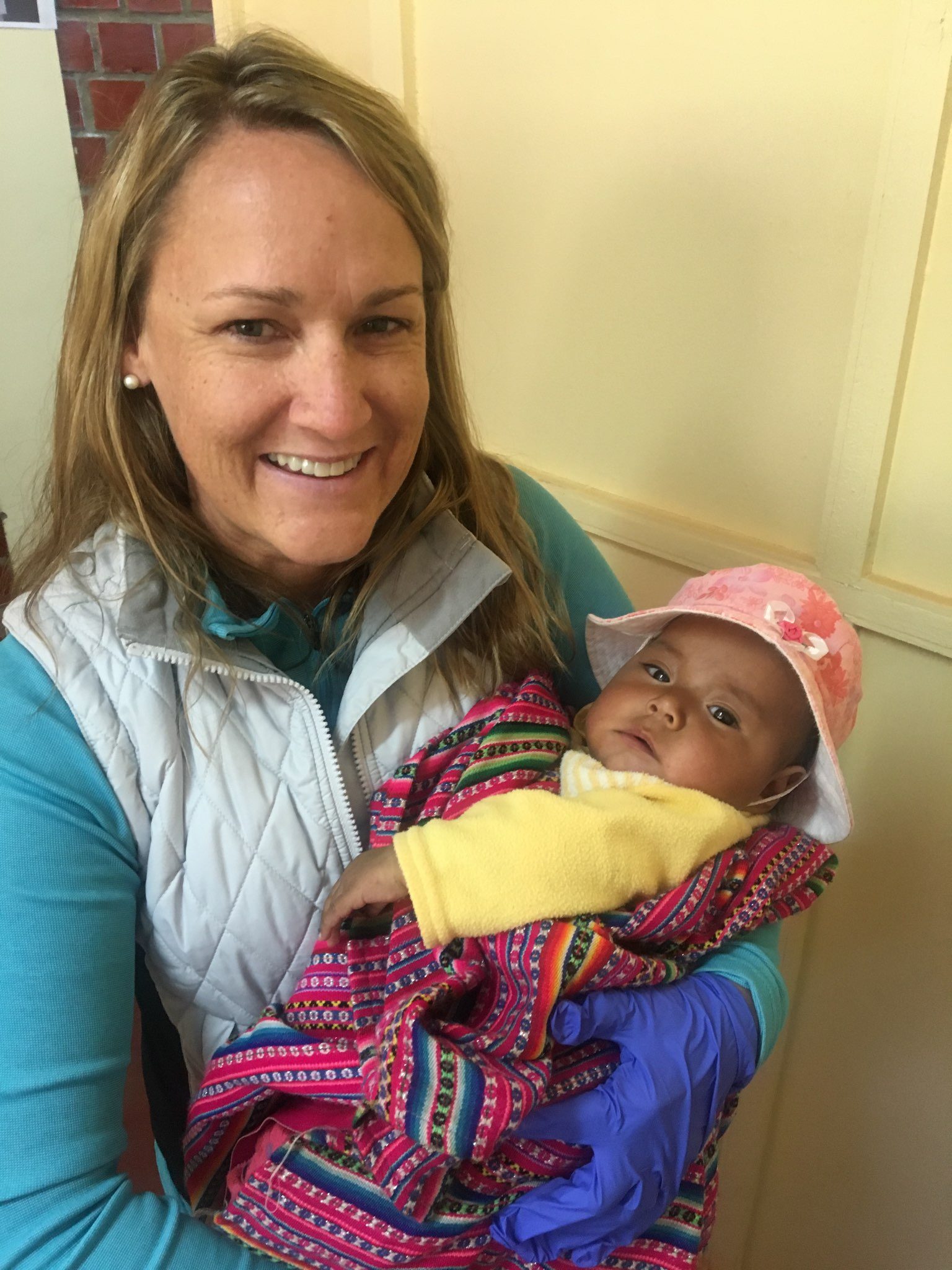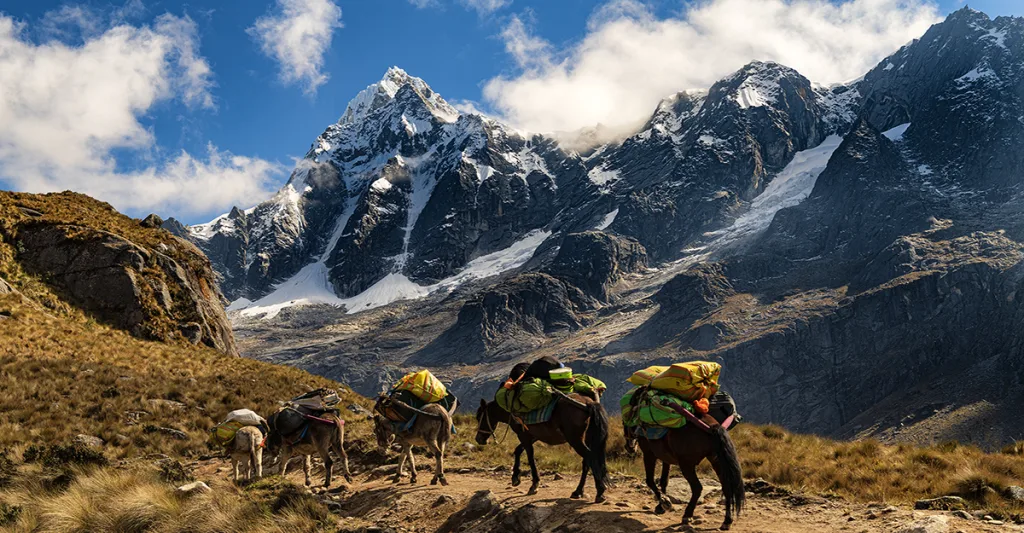Whether she is on high-tech rescue missions as a flight nurse in Colorado or on mission trips, providing care with few resources to people in villages in the Andes Mountains of Peru, Kelly Thompson, RN, CFRN, is known for making a difference in patients' lives.
[caption id="attachment_77404" align="alignleft" width="225"] Flight nurse Kelly Thompson, RN, holds an infant during her Peru mission trip.[/caption] Thompson's commitment to outstanding patient care and her passion for mission trips haven't gone unnoticed. The DAISY Foundation honored Thompson in December 2018 with the DAISY Award for Extraordinary Nurses. It's not easy for flight nurses to develop emotional connections with patients and families. Their time with patients is limited and hectic. But that never stops Thompson from forming even long-term ties with patients and families. A flight nurse manager for Careflight in Grand Junction, Colo., Thompson was at the scene of a car wreck in Aspen a few years ago, in which there were multiple fatalities. A boy, whose parents died in the accident, was severely injured but alive. The crew flew the child to a trauma center that happened to be near where Thompson lived. She didn't want the child to be alone in the hospital, so Thompson recruited her teenager to sit with the patient until family members arrived. Thompson checked on the child in the hospital daily when she was off duty and befriended the family. "They were hesitant to fly him home back east, and they asked me if I would accompany him on the plane," Thompson said. "I did."
Flight nurse Kelly Thompson, RN, holds an infant during her Peru mission trip.[/caption] Thompson's commitment to outstanding patient care and her passion for mission trips haven't gone unnoticed. The DAISY Foundation honored Thompson in December 2018 with the DAISY Award for Extraordinary Nurses. It's not easy for flight nurses to develop emotional connections with patients and families. Their time with patients is limited and hectic. But that never stops Thompson from forming even long-term ties with patients and families. A flight nurse manager for Careflight in Grand Junction, Colo., Thompson was at the scene of a car wreck in Aspen a few years ago, in which there were multiple fatalities. A boy, whose parents died in the accident, was severely injured but alive. The crew flew the child to a trauma center that happened to be near where Thompson lived. She didn't want the child to be alone in the hospital, so Thompson recruited her teenager to sit with the patient until family members arrived. Thompson checked on the child in the hospital daily when she was off duty and befriended the family. "They were hesitant to fly him home back east, and they asked me if I would accompany him on the plane," Thompson said. "I did."
From 'One and Done' to Annual Mission Trips
Thompson spends every July (except in 2020 because of COVID-19 and closed borders) on a mission trip to care for patients in the Quechuan villages in the Ancash Region of the Andes. In fact, she is a 2019 DAISY Medical Mission Grant Recipient. The DAISY Foundation helped fund her tenth mission trip to Peru in July 2019.
"I thought it was going to be a one-time obligatory nursing trip," she wrote in a grant proposal she shared with Nurse.com. "Instead, after seeing the amount of suffering, it became my lifelong journey."
[caption id="attachment_77406" align="alignright" width="400"] A healthcare staff member takes notes while caring for a Peruvian elder during the mission trip.[/caption] Thompson often is the only nurse among physicians, residents, and some non-medical volunteers on the trip to villages at elevations of 12,000 to 15,000 feet. She does triage, assists with surgeries, gives vaccinations, starts IVs, and administers antibiotics and fluids, etc. Thompson also makes house calls to those too ill to come to the clinics. "By trade and by survival, most are farmers," she said. "The terrain is very steep, so we take care of a lot of joint issues from years of walking up and down this steep terrain with their harvest on their backs. "There really isn't medical care in the area," Thompson said. "We have some primary care patients that we see every year, and then we take care of any emergent things that come up, including illness, infection, and fractures. Sometimes we have to go to the nearest established town and rent an operating room to do surgery." Thompson and her colleagues saw about 300 patients a day in Peru. She also uses her skills as a nurse to educate the Peruvian people.
A healthcare staff member takes notes while caring for a Peruvian elder during the mission trip.[/caption] Thompson often is the only nurse among physicians, residents, and some non-medical volunteers on the trip to villages at elevations of 12,000 to 15,000 feet. She does triage, assists with surgeries, gives vaccinations, starts IVs, and administers antibiotics and fluids, etc. Thompson also makes house calls to those too ill to come to the clinics. "By trade and by survival, most are farmers," she said. "The terrain is very steep, so we take care of a lot of joint issues from years of walking up and down this steep terrain with their harvest on their backs. "There really isn't medical care in the area," Thompson said. "We have some primary care patients that we see every year, and then we take care of any emergent things that come up, including illness, infection, and fractures. Sometimes we have to go to the nearest established town and rent an operating room to do surgery." Thompson and her colleagues saw about 300 patients a day in Peru. She also uses her skills as a nurse to educate the Peruvian people.
"After the official mission is complete, I travel with a local missionary to the shanty towns outside of Lima, where we provide teaching on subjects such as nutrition, pregnancy health, decreasing childhood mortality, and other topics," Thompson said. "We work on better sanitation and provide water filters that I receive through donations."
She calls the trek her "yearly refresher."
Making Do With Limited Supplies
Thompson spent part of her nursing career in the ED, always looking at the numbers and churning out patients, she said. Providing care to people in Peru brings her back to nursing's roots. "I go from a very high-tech helicopter with all the advanced, life-saving, latest equipment to making due with what we have, which is very limited," she said. "In the helicopter, I can run all the labs that I want on a 30-minute flight and arrive to the ER with all this data. Out there, you can't run any kind of labs. It's all based on symptoms and the physical assessment that we do." Modern-day society wants a quick fix, but in the Andes, it's different.
"These people are incredible," she said. "They are strong. If you're between the ages of 8 or 98, you're working in the fields. They have no running water and electricity, but yet they're the happiest people. They're so grateful for anything that we do. It's very soul cleansing for me."
Just getting to the people isn't easy, even for someone such as Thompson, who lives at high altitude in Colorado. Nurses and other healthcare professionals who embark on mission trips to Peru must have good baseline physical fitness. They also have to understand they won't be able to fix some things that would be an easy fix in the U.S. That's because of the patients' limited access to follow-up care, medication and more. One example is a teenage boy in the mountains who suffers from seizures. The medications he needs require follow-up care, so he can't be on them long term. In another case, a young woman, about 17 years old, came to Thompson holding her baby. She was hesitant to let Thompson look at the baby. But when she finally agreed, Thompson saw the 9-month-old had a cleft lip and palate.
"That would have been fixed immediately in the states," she said. "I asked the mom how she was feeding her and she showed me how she basically milks her breast and drop-by-drop drops it in the baby's mouth."
In the village where the mother lived, the local shaman was convinced the baby's condition was because of evil spirits, so he shunned the woman and her child from the village. However, Thompson found some missionaries several valleys away who could provide the care needed to fix the cleft lip and palate. Thompson said she hopes that someday she'll be able to work full time in Peru, instead of annual mission trips. For now, she looks forward to when the pandemic eases enough for her and the team to go back.







